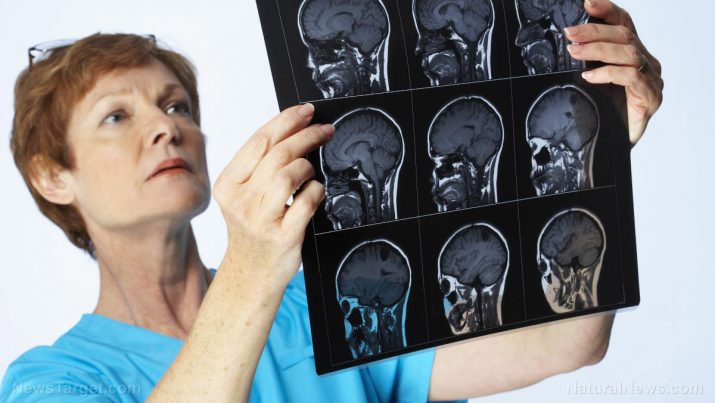
Hindbrain hernia – causes, side effects and treatments at NaturalPedia.com
Monday, May 07, 2018 by Janine Acero
http://www.naturalpedia.com/hindbrain-hernia-causes-side-effects-and-treatments-at-naturalpedia-com.html

Hindbrain herniation (also called Chiari malformation type 1) is a condition that describes a structural abnormality in the lower parts of the cerebellum (the part that controls balance) and the skull, wherein these parts are moved downwards through the foramen magnum (the large hole at the base of the skull that allows passage of to the spinal cord), without involving the brainstem.
Primary or congenital hindbrain herniation may be caused by structural defects in the brain and spinal cord during fetal development and presents clinically as adults. Causes include bone softening, tumor, or previous meningitis.

Known symptoms and risk factors for a hindbrain hernia
The malformation is usually first noticed in adolescence or adulthood, often by accident during an examination for another condition.
A headache is the hallmark symptom of a hindbrain hernia, especially after sudden coughing, sneezing or straining. Other signs may vary from person to person, and may include:
- Curvature of the spine (scoliosis)
- Depression
- Difficulty swallowing or speaking
- Dizziness
- Hearing or balance problems
- Insomnia
- Muscle weakness or numbness
- Neck pain
- Ringing or buzzing in the ears (tinnitus)
- Problems with hand coordination and fine motor skills
- Vomiting
Some symptoms may change for some individuals, and some individuals may not show any symptoms.
Infants with a hindbrain hernia may have the following symptoms:
- A stiff neck
- A weak cry
- An inability to gain weight
- Arm weakness
- Breathing problems
- Developmental delays
- Difficulty swallowing
- Excessive drooling
- Gagging or vomiting
- Irritability when being fed
People with this condition often have other diseases, including hereditary neurological and bone abnormalities. Other related conditions that can increase the risk of a hindbrain hernia include:
- Hydrocephalus – An accumulation of excess fluid in your brain.
- Myelomeningocele – A type of birth defect where the spinal canal and backbone don’t close before the baby is born.
- Spinal curvature – A common condition, especially with children who have type 1 Chiari malformation.
- Syringomyelia – A hole or cyst in the spinal column, called a syrinx.
- Tethered cord syndrome – A neurological disorder wherein the spinal cord attaches to the bone of the spine, which can cause damage to the lower body. The risk is higher in people with myelomeningocele.
Body systems harmed by a hindbrain hernia
A hindbrain hernia can have complications such as:
- Development of syrinx
- Long-term pain
- Paralysis
- Permanent damage to muscles or nerves
Early detection and early treatment are important to help prevent these complications.
Food items or nutrients that may help prevent a hindbrain hernia
Our food choices influence not just our mood, but also our memory, cognitive skills, and mental well-being. Add the following foods to your regular diet for a healthier brain:
- Beans
- Berries
- Colored veggies (carrots, eggplants, pumpkins)
- Leafy greens
- Nuts
- Oily fish (herring, salmon, sardines, trout)
- Olive oil
- Poultry (chicken, turkey)
- Wine (one small glass per day)
- Whole grains
Lifestyle changes, such as the ones below, also play a part in the healthy development of the brain.
- Always look straight ahead when reading; avoid bending your head.
- Avoid certain foods such as alcohol, caffeine, too much salt and aspirin, as they can exacerbate your symptoms.
- Get enough sleep.
- People with type 2 Chiari malformation are prone to irritable bowel syndrome (IBS). Avoid foods containing gluten to prevent IBS symptoms and malabsorption of nutrients.
- Wear cushioned shoes that reduce the pounding effect on the neck while walking.
Treatments, management plans for a hindbrain hernia
Treatment will depend on your symptoms, age, and overall health, as well as the severity of the condition.
- With no symptoms: Your health may be watched closely. This may include frequent physical exams and MRI tests.
- With symptoms: Your healthcare provider may prescribe medicines to reduce pain, or may opt for surgery in order to relieve pressure on the brain or restore the flow of spinal fluid.
Where to learn more
- Essential brain food: Here’s why you probably need DHA supplements
- Scientists finally issue warning against canola oil: Study reveals it is detrimental to brain health, contributes to dementia, causes weight gain
- Herbs to help you age gracefully: Support for the brain, heart, digestion, and more
- Vitamin D Key to Healthy Brain
- Good Nutrition Tips To Keep A Healthy Brain
Summary
Hindbrain herniation is a condition wherein the lower parts of the cerebellum and the skull are moved downwards through the foramen magnum without involving the brainstem.
Primary or congenital hindbrain herniation may be caused by structural defects in the brain and spinal cord during fetal development, and are often detected in adolescence or adulthood.
Sources include:
Tagged Under: Tags: Hindbrain hernia





